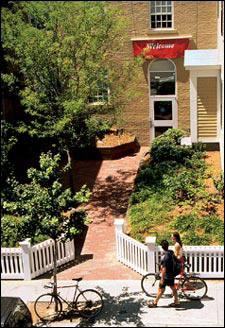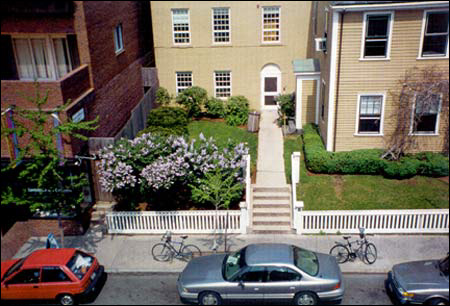Prize-winning restorations:
Two buildings from Harvard honored by Cambridge

For the most part the photos illuminating the dark theater are indistinguishable from one another. This is the building before… and this is the building after.
According to Charles M. Sullivan, executive director of the Cambridge Historical Commission who helped guide Cambridge organizations and homeowners through these restoration projects, the objective of the restoration is – no change.
“The point is not to leave a personal imprint on the building, it is to let the building speak for itself,” said Sullivan as he lingers on a modern-day slide of 53 Church, a Harvard-owned building. When the slide show is finished, Sullivan concludes, “And that is the universe of prize-winning restoration in Cambridge in 2002-2003.”
Here in the Cambridge YMCA’s Durrell Hall, a turn-of-the century community theater, which was reclaimed from its modern use as a nerf ball court to become one of this year’s award winners, the City of Cambridge is presenting the 2003 Preservation Awards to outstanding projects. Among the dozen or so projects are two Harvard buildings. Harvard joins the Massachusetts Institute of Technology, the Jehovah’s Witness, and individual homeowners who are being commended this year for their efforts to conserve and protect the city’s architecture.
The projects range from those born from a surprise discovery of original design elements in the course of repairs to model efforts to revive and modernize “tired” buildings.

Harvard’s award-winning project at 53 Church, also known as the Torrey Hancock house (1827), consisted of the revitalization of one of the city’s few remaining wood frame buildings from the Federalist period. The challenge was fitting the landmarked building with modern mechanics and wiring for today’s needs while preserving its original character. The 2.5 story building, including its adjoining brick wing (1928) is now home to Harvard’s Division of Continuing Education Computer Facilities.
The project integrated the two buildings, made both accessible to persons with disabilities, and added new heating, cooling, electrical, and wiring necessary for classrooms, workrooms, and a new computer lab. Harvard took the extra step of installing a multi-stop elevator to increase access to the two buildings rather than leveling the floors. In addition to the updates, external details were carefully refreshed. The result: A “wonderful transition to the next 100 years,” according to representatives of BTA Architects Inc. who worked on the project. Fifty-three Church has also been selected for a merit award for public architecture from the Massachusetts Architectural Access Board.
For 19 Ware, one the first brick apartment buildings ever built in Cambridge in the late 19th century, project managers went to great lengths to discover and replicate the type, shape, and color of the original brick mortar. With restored mortar and a replica of the original oak wood entrance replacing a 50s-style institutional aluminum door, the building was returned to its original state.
While these buildings were among Cambridge’s award winners this year, Harvard has revived more than a dozen such houses over the past five years in the regular course of upkeep and repairs or to fit them with modern functions, and more are slated for restoration in the years to come. In some cases the promise of new development projects such as the Center for Government and International Studies were paired with restoration projects like 96 Prescott, a former rooming house that was relocated earlier this year.
“When people think of Harvard’s construction activities, their focus is most often on the new buildings under planning or development, but we have a whole initiative under way to preserve the historic structures we own,” said Kathy Spiegelman, chief university planner and former associate vice president for Harvard Planning and Real Estate. “Those who play a stewardship role for Harvard’s buildings take great pride in combining preservation goals with program needs.”
As individual contributions and when viewed with a wider lens, projects such as these can have a lasting impact on a community.
“Cambridge’s older architecture contributes to the beauty of the fabric of this community. Thank you for making our community what it is . . . for bringing back the past,” said Mayor Michael Sullivan at the ceremony.




